| ALL ABOUT PICTURE FRAMES
|
 |
| When you decide to order a framed print, or a picture frame for an existing print or original artwork, there are many considerations to make. The material from which the frame is constructed affects weight and appearance, the ideal width and depth of the frame depend on the size of the image, and a style must be chosen that best highlights the image. There are also other uses for picture frames, beyond the traditional purpose of bordering a painting or photograph on the living room wall.
PICTURE FRAMES SUMMARY |
|
In the body of this article, we will discuss the following topics in detail:
Picture Framing Material
- Wood, aluminium and polystyrene (styrofoam) are the most common picture frame materials.
- Solid wood is very popular, though metal and styrofoam frames provide cost, quality, lightweight options.
Picture Framing Measurements
- While the artwork size refers to the actual dimensions of the image, it is important to remember that the lip of the frame will overlap the image about 1/4" on each of the four sides.
- When measuring your artwork, do not make calculations for mat size or lip overlap. The framer will make these alterations for you when he begins to make the frame.
Picture Frame Styles
- There are many frame styles including: modern, classical, rustic, canvas floaters and shadow box frames.
- Frames may be unfinished wood, coated with a varnish, a thin decorative layer, or carved gesso or clay ornamentation.
What Can Be Framed
- Poster frames are generally made of light wood, plastic or metal. They must be lightweight since they are generally large in size.
- Outdoor frames are available for decorating sitting areas, advertising and much more. These frames are sturdy and weatherproof.
|
|
| WHAT ARE PICTURE FRAMES MADE OF? |
 |
|
There are three different types of material commonly used to create picture frame mouldings: wood, metal and styrofoam. Each material has a unique manufacturing process, as outlined below, as well as pros and cons depending on the customer's desired use for the frame.
|
| |
Wood |
Metal |
Styrofoam |
| |
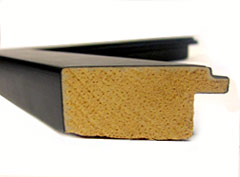 |
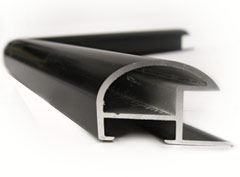 |
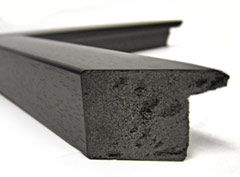 |
| HOW THEY ARE MADE |
Wood (timber) can be divided into two broad categories: hardwoods and softwoods. "Hardwood" generally refers deciduous trees, or those that lose their leaves each autumn. "Softwood" refers to coniferous trees, or evergreens. Frames are often made of soft hardwoods, which are easier to sculpt, but resist warping and breaking. When a frame is described as "walnut" or "mahogany", this often refers to the finish or color, not the species of wood used to make the frame. Some wood frames have a thin veneer (coating) that provides color and often a faux wood grain design. Other frames have clay or gesso pressed to the wood surface and molded, creating intricate designs and ornamentation. Still other frames are pure wood, with only a varnish coating for protection and color.
|
Most metal picture frames available today are made from aluminium. This metal has become the primary choice because of its resistance to corrosion, relative softness and low cost. It is also one of the easiest metals to which to apply paint. The uniform width and profile is achieved by a process called extrusion. This involves pulling a piece of softened metal through a die - a reverse of the desired shape, which will form the metal as it is drawn through. Metal picture frames generally have quite basic profiles, a simple rounded or flat face, occasionally with textured detailing.
|
Officially called Polystyrene frames, the primary selling point of these frames is their relatively low price. These frames are often made from a mix of recycled and virgin plastic. This is because new polystyrene is too flexible and recycled is too stiff. Once mixed, pellets go through an extrusion process, much like metal frames. The difference, however, is the wide range of profiles that can be achieved, without the addition of a clay or gesso surface, as in wood frames. Once formed, the moulding is overlaid with thin foil sheeting that results in an exterior of a polystyrene frame looks like any other wood picture frame. |
| PROS |
- Solid construction from straight, finger-jointed wood sections
- Will not warp or bow over time
- Attractive wood grain finishes
|
- Thin frames can hold a lot of weight
- Easy to change artwork or disassemble frame at home
- Lightweight, with simple, modern styles
|
- Lightweight material looks the same as wood when finished
- Easy to form intricate designs and ornamentation
- Generally less expensive than wood or metal frames
|
| CONS |
- Large frames become quite heavy and can be difficult to safely display, more expensive
|
- No intricate designs available, often available only in black, gold, bronze or silver
|
- If the plastic is too hard or too soft, the frame can break off from the hanger
|
|
| WHAT DO ALL THOSE TERMS AND MEASUREMENTS MEAN?
|
 |
|
When preparing to purchase a picture frame, many measurements will be stated and requested, and a firm understanding of these terms will help to ensure you receive exactly the size and style of frame you were seeking. The alphabetical list below provides definitions and examples of the most commonly used terms.
Artwork Size
The measurements of the artwork itself, before it has been placed in a frame or behind a mat. This includes two dimensions: the horizontal (width) and the vertical (height). Be sure to measure to the very edge of the artwork. Remember that any mat or picture frame lip will cover a small amount of the artwork (generally 1/8" to 1/4" on each side). Do not factor this 1/8" or 1/4" into your measurement, but do ensure that no significant parts of the image will be covered by this overlap.
Artwork Thickness/Depth
The depth of the frame contents, which may include any of the following: artwork, fillets, mat(s), plexiglass or glass cover, backing. Once the contents are assembled (stacked), this measurement will be taken from the top of the glass to the base of the backing, and is important to ensure the entire "sandwich" will fit within the rabbet of the frame.
Canvas Floater Frame measurements
If you are framing your canvas painting or print with a floater frame, you must ensure that your measurement of the artwork size is completely accurate. The best way to do this is to measure across the top horizontal edge and the left vertical edge. This edge is where the canvas corner is folded over, so it is the thickest part of the piece.
The framer will add an additional 1/4" to 1/2" into your artwork size to determine the frame size. This is the gap left between the canvas and the frame, to give the appearance of a "floating" canvas.
Frame Depth/Height
This measurement refers to the distance between the frame face and the back of the frame. This is the distance the frame will sit out from the wall when hung. Different frame heights create different degrees of shadow and depth in the final display.
Frame Face Width
The face of the picture frame is the front piece that will be the visible border around the artwork. The frame face width is the dimension of the face, from the inner edge to where the drop edge (the depth/height measurement) begins. Most frame faces range in width from 3/4" to 3 1/2".
Frame Lip
The lip of the frame is the piece that will extend slightly into the artwork. Generally, the lip covers 1/4" on each side of the image. This overlap is required to keep the artwork behind the frame, and to hide any unfinished edges. The lip also conceals the rabbet, in which the contents of the frame will sit.
Frame Size
The frame size refers to the size of the contents that fit within the frame. If the frame is made to fit an 8x10" image (regardless of the frame face width), the frame size is 8x10". Sometimes, the actual size of the opening in the frame will be a bit more (approximately 1/8"), to ensure there is enough space for the artwork.
Mat Offset
The mat offset indicates how much the inner edge of the mat will overlap the artwork. Much like the lip of a frame, the mat offset is required to keep the artwork behind the mat, and to hide any white or unfinished edges.
Mat Opening
The mat opening is the space between the inside edges of the mat, also called the "viewing window". Each dimension t will generally be 1/8" to 1/4" smaller than the artwork size, to allow for the mat offset.
Mat Width
The mat width is the amount of mat visible on each side of the artwork. For instance, if you would like a 2" mat surrounding the image, the mat width is 2". It is important to remember that the lip of the frame will overlap the mat by a small amount.
Outer Frame Size
Though rarely referred to, the outer frame size is the measurement from one outside edge of the final, framed print to the other. Since this measurement has no bearing on the artwork size, it is only consulted in instances where there is limited space on the wall where the art is to be displayed. For example: an 8x10" artwork size surrounded by a 3" wide frame will have an outer frame size of 11x13".
Profile
The profile of a frame refers to a cross-section view which shows the frame height/depth, frame face, lip and rabbet.
Rabbet
The recessed area behind the lip of the frame where the contents of the frame will sit. The rabbet measurement should be roughly the same size as the artwork depth/thickness, to ensure the contents are tightly pressed to the front of the frame. The exception to this is in shadow box frames, where a deeper rabbet is required to create the space between the glass and the backing (wherein the three-dimensional object will sit).
|
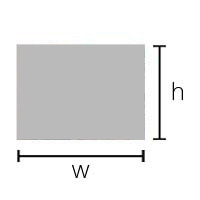
Artwork Size
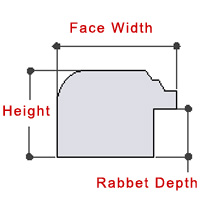
Frame moulding measurements.
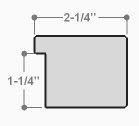
The profile of a frame moulding.
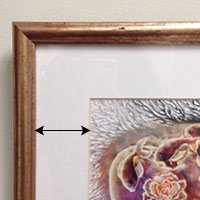
The mat width.
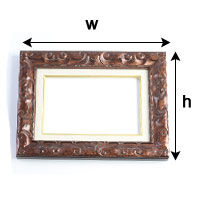
The outer frame size.
|
| PICTURE FRAME STYLES |
 |
|
There is as wide a range of picture frame genres, profiles, and finishes as there is unique styles of art to be framed. Different frames have been used over the years to encase different styles of artwork. Likewise, today, one frame may be ideal for a modern, color photograph, while another frame is better suited to a charcoal sketch or painting.
Another thing to keep in mind when planning your frame is the size of the frame compared to the size of the artwork. Generally, frames with a large face width (2.5" to 4") are best for artwork that is 18x24" or larger. For instance, framing an 8x10" image with a 3" frame will often take attention away from or overshadow the art. Likewise, a very thin (3/4" or 1") frame on a 24x36" or larger image may make the artwork appear too bulky, and this will distract from the overall display. At times, however, these adverse effects are exactly what the artist or consumer desires.
Within some frame moulding profiles is the subcategory of "reverse". This means that the highest part of the frame is at the inner lip, with the profile descending toward the outer edge. In some cases, this type of frame can detract from the artwork, leading the viewer's eye away from the image. If the image is strong enough, however, a reverse moulding can create a dynamic and visually interesting border.
|
WOOD/POLYSTYRENE FRAME MOULDING PROFILE SHAPES
|

Flat |

Curve |

Stepped |

Scoop |

Slope |

Reverse Curve |

Reverse Scoop |

Reverse Slope |

Reverse Stepped |

Swan Neck |

Steep Curve |

Ornate |

Triangular |

Bevelled |

Shadow Box |
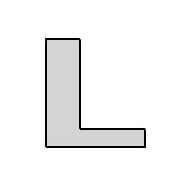
L Shape |
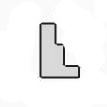
Stepped |
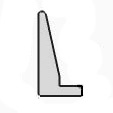
Tapered |
|
|
|
METAL FRAME MOULDING PROFILE SHAPES |

Rounded Top |

Rounded Top,
Ridged |

Flat Top |

Curve |

3/4" Floater |
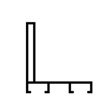
1-1/2" Floater |
|
| FRAME COLORS & FINISHES |
 |
| In addition to the wide range of profile shapes, picture frames are available in a variety of colors and finishes.
In wood frames, some shades are achieved by simply staining the wood, while others create a new grain or design by overlaying the wood with a coating that completely transforms the look of the material. Some wood frames have a high shine or glossy finish, while others are matte.
A layer of gesso is another way to change the look of a frame. Gesso is a mixture of a binder (often acrylic latex) and chalk or other pigment. After a thick application onto the flat wood base, the hardened gesso can be etched or carved, and an intricate design created, prior to the final application of gold leaf or other coating. Alternately, clay may be used and formed much like the gesso.
Styrofoam picture frames are virtually indistinguishable from wood frames once they are assembled, though they do not require a gesso layer - the ornate details can be added when the plastic is moulded.
In the case of metal picture frames, the common black, gold and silver frames may have a high-shine finish, or a brushed or frosted, matte finish. Other detailing is usually limited to textured ridges on the drop edge (shown in the profiles above) and a choice of a flat or curved top.
As mentioned above, certain picture frames are often best suited to certain types of artwork. While this guide is by no means the final word, it may be helpful to focus your choices once you determine into which category your own artwork fits.
- Rustic Picture Frames
Frames with a raw, natural wood look to them are ideal for bucolic natural images such as photographs of an old farm, or a landscape painting with visible brushstrokes and thick painting style. While these frames are available in a variety of finishes, they will always have a visible wood grain, and often the knots and ridges naturally occurring in the wood will be left or highlighted, to add texture and depth.
- Classical Picture Frames
Frames that look like they should be bordering a Rembrandt or Japanese art print most likely fall under the heading of Classical. This can include Baroque, Renaissance, or Victorian-era frames. These frames are generally quite ornate, and often finished in gold foil or paint. Any painting or print in a classical style would look stunning in a classical frame. This style of frame may also be referred to as Vintage.
-
Modern/Contemporary Picture Frames
Modern picture frames often feature a flat face and solid wash. Black and white are the most common shades, though any full-color, unornamented frame could fall into this category. Contemporary frames tend to work well with grayscale or boldly hued photographs, abstract paintings, and pencil or charcoal drawings.
-
Frameless Picture Frames
Another style of modern frame is the one without any frame at all! These frames sandwich the artwork between two panes of glass or plexiglass. The bundle is then held together by metal or clear plastic clips, and hung on the wall from hardware affixed to the back. This style of frame is commonly used for prints, matted artwork and photographs, when the artwork needs to be the sole focus of the display.
-
Canvas Floater Frames
A canvas floater frame is an alternate option to framing your canvas print or hanging it unframed. Generally a modern matte or glossy black, white or gray, floater frames are also available in rustic designs and metallics. Suitable for any gallery wrapped canvas, a floater frame does not require any lip overlap, because the back of the canvas is affixed to the back of the frame. As such, no part of the artwork will be hidden, and the attracted wrapped edge of the canvas is visible as well.
-
Shadow Box Frames
Shadow boxes are used to display three-dimensional objects behind glass. Often seen protecting sports jerseys or baptism dresses, a shadow box frame has a very deep rabbet, which allows extra space between the glass and the backing. How much space the object needs depends on the object. Shadow box frames are available in various rabbet depths, from 3/4" to 2 1/4".
|
WOOD & METAL PICTURE FRAME STYLES
|
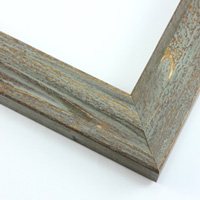
Rustic Raw |
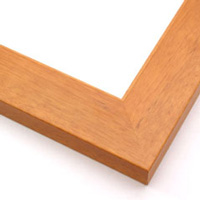
Rustic Finished |
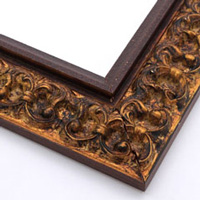
Classical Simple |
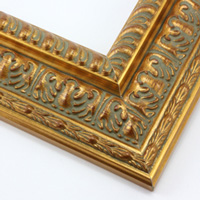
Classical Ornate |
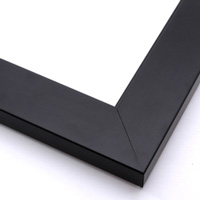
Modern Flat |
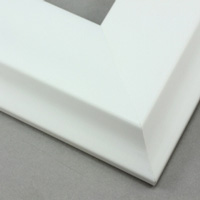
Modern Scoop |
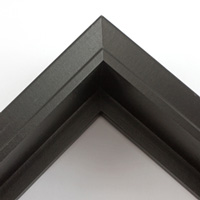
Canvas Float Modern |
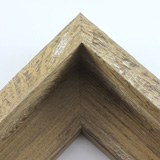
Canvas Float Rustic |
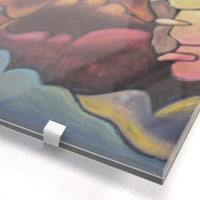
Frameless |
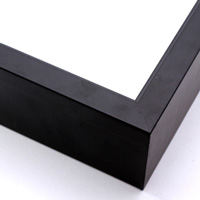
Shadow Box |
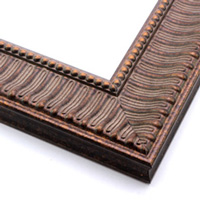
Classic Modern |
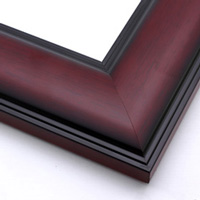
Classic Mahogany |
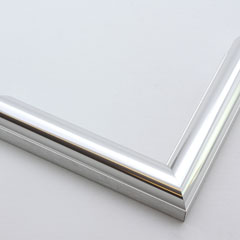
Metal, High Shine
|
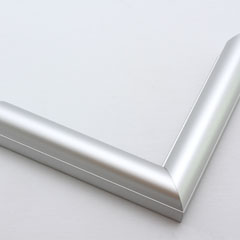
Metal, Frosted
|
|
|
|
|
|
| WHAT CAN BE FRAMED, BESIDES FINE ART? |
 |
|
Any painting, sketch, graphic print, 3D sculpture or canvas can be framed. But the list doesn't stop there. Posters and even outdoor signs can be framed!
Poster frames are generally made of narrow wood or metal. They are commonly covered with plexiglass (acrylic) instead of real glass, because glass is very heavy; in a poster-sized frame, weight quickly becomes a detriment. Because of this, frameless versions are popular as well.
Weather- and water-proof frames are available in a vast array of sizes, and can be used to frame garage sale signs, adorn outdoor sitting areas, or display menus in front of a restaurant.
Most outdoor frames are made of metal, since wood will eventually react to the elements. The frames are sealed to keep moisture from reaching the contents, and treated to prevent rusting. Often these frames also include safety features that will keep them from being carried off. These frames are available for any artwork from a small menu to a large bus stop advertisement. Larger frames often have the cover set on hinges, so the image can be easily changed.
|

An outdoor picture frame.
|
|
There are nearly as many picture frame styles as there is artwork to display in them. This article is intended to give consumers an overview of what is available, and what kind of art each style is generally paired with. In the end, however, the choice is entirely the customer's. After all, they are the one who must display and view the artwork each day.
If you have any questions or concerns, or require further assistance in selecting a picture frame for your artwork, do not hesitate to contact us. Our knowledgeable staff are available to help you with any of your frame or fine art printing needs.
|
|
© 2002-2025 - KeenART Media Ltd.
|
|
| |
|

